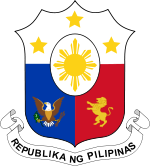- Chief Justice of the Supreme Court of the Philippines
-
Chief Justice of the Supreme Court of the Philippines Style His/Her Honorable Appointer Presidential appointment upon nomination by the Judicial and Bar Council Term length Retirement at the age 70 Inaugural holder Cayetano Arellano Formation June 11, 1901 Website Official Website Philippines 
This article is part of the series:
Politics and government of
the PhilippinesLegislature- Congress (15th Congress)
- Senate
- House of Representatives
- Speaker
- Legislative districts
- Sectoral representation
ExecutiveJudiciaryRelated topics
Other countries · Atlas
Philippine Government Portal
The Chief Justice of the Supreme Court of the Philippines presides over the Supreme Court of the Philippines and is the highest judicial officer of the government of the Philippines. The position is currently held by Renato Corona, who was appointed Chief Justice on May 17, 2010.
Contents
Duties
The power to appoint the Chief Justice lies with the President, who makes the selection from a list of 3 nominees prepared by the Judicial and Bar Council. There is no material difference in the process of selecting a Chief Justice from that in the selection of Associate Justices. As with the other Justices of the Supreme Court, the Chief Justice is obliged to retire upon reaching the age of 70, otherwise there is no term limit for the Chief Justice.
The Constitution does not ascribe any formal role to the Chief Justice other than as an ex-officio Chairman of the Judicial and Bar Council and as the presiding officer in any impeachment trial of the President. The Chief Justice is also required to personally certify every decision that is rendered by the Court. He or she carries only 1 vote out of 15 in the Court, and is generally regarded, vis-a-vis the other Justices, as the primus inter pares rather than as the administrative superior of the other members of the Court.
Still, the influence a Chief Justice may bear within the Court and judiciary, and on the national government cannot be underestimated. In the public eye, any particular Supreme Court is widely identified with the identity of the incumbent Chief Justice, hence appellations such as "The Concepcion Court", "The Fernando Court", or "The Puno Court". Moreover, the Chief Justice usually retains high public visibility, unlike the Associate Justices who tend to labor in relative anonymity, with exceptions such as Associate Justice J.B.L. Reyes in the 1950s to 1970s.
By tradition, it is also the Chief Justice who swears into office the President of the Philippines. One notable deviation from that tradition came in 1986. Due to the exceptional political circumstances culminating in the People Power Revolution, on February 25, 1986, Corazon Aquino took her oath of office as President before then Associate Justice Claudio Teehankee in San Juan just minutes before Ferdinand Marcos took his own oath of office also as President before Chief Justice Ramon Aquino. Marcos fled into exile later that night.
List of Chief Justices
†-José Abad Santos was unable to preside over the Supreme Court of the Philippines due to the outbreak of World War II. Timeline

Notable Chief Justices
- José Yulo was the only former Speaker of the House of Representatives to be subsequently appointed as Chief Justice. Another, Querube Makalintal, would be elected as Speaker of the Interim Batasan Pambansa after his retirement from the Court. On the other hand, Marcelo Fernan would, after his resignation from the Court, be elected to the Senate and later serve as its President. Other Chief Justices served in prominent positions in public service after their retirement include Manuel Moran (Ambassador to Spain and the Vatican), and Hilario Davide, Jr. (Ambassador to the U.N.). The most prestigious position held by a former Chief Justice was undoubtedly that of Cesar Bengzon, who was elected as the first Filipino to sit as a judge on the International Court of Justice shortly after his retirement in 1966.
- Roberto Concepcion was reputedly so disappointed with the Court's ruling in Javellana v. Executive Secretary where the majority affirmed the validity of the Marcos Constitution despite recognizing the flaws in its ratification, that he retired 2 months prior to his reaching the mandatory retirement age of 70. 13 years later, after the ouster of Marcos, the 83-year old Concepcion was appointed a member of the 1986 Constitutional Commission tasked with drafting a new Constitution. Drawing from his experiences as Chief Justice in the early days of martial law, Concepcion introduced several new innovations designed to assure the independence of the Supreme Court, such as the Judicial and Bar Council and the express conferment on the Court the power to review any acts of government.
- The longest period one person served as Chief Justice was 18 years, 294 days in the case of Cayetano Arellano, who served from 1901 to 1920. Arellano was 73 years, 29 days old upon his resignation, the greatest age ever reached by an incumbent Chief Justice, and a record unlikely to be broken with the current mandatory retirement age of 70.
- The shortest tenure of any Chief Justice was that of Pedro Yap, who served as Chief Justice for 73 days in 1988. Other Chief Justices who served for less than a year were Felix Makasiar (85 days), Ramon Aquino (78 days) and Artemio Panganiban (352 days). Of these Chief Justices, all but Aquino left office upon reaching the mandatory retirement age of 70; Aquino resigned in 1986 after the newly-installed President Corazon Aquino asked for the courtesy resignations of all the members of the Court.
- The oldest person appointed as Chief Justice was Pedro Yap, who was 69 years, 292 days old upon his appointment in 1988. Other persons appointed as Chief Justice in their 69th year were Felix Makasiar (69 years, 280 days old) and Artemio Panganiban (69 years, 13 days old). The youngest person named as Chief Justice was Manuel Moran, who was 51 years, 256 days old upon his appointment.
- Claudio Teehankee, Sr. had to wait for nearly 18 years as Associate Justice before he was appointed as Chief Justice. He was twice bypassed by Ferdinand Marcos in favor a more junior Associate Justice before he was finally appointed Chief Justice by Corazon Aquino. Of the Filipino Associate Justices, Florentino Torres and J.B.L. Reyes served over 18 years in the Court without becoming Chief Justice. In contrast, Pedro Yap had served as Associate Justice for only 2 years, 10 days before he was promoted as Chief Justice.
- The longest lived Chief Justice was Cesar Bengzon, who died in 1992 aged 96 years, 97 days old. Two other Chief Justices lived past 90: Ricardo Paras (93 years, 235 days) and Querube Makalintal (91 years, 322 days).
- The youngest Chief Justice to die was José Abad Santos, who was executed by the Japanese army in 1942 at age 56 years, 77 days. The youngest Chief Justice to die from non-violent causes was Fred Ruiz Castro, who died in 1979 of a heart attack inflight to India, at age 64 years, 231 days. Abad Santos, Castro and Manuel Araullo are the only Chief Justices to die while in office.
See also
- Associate Justice of the Supreme Court of the Philippines
- Supreme Court of the Philippines
- Constitution of the Philippines
Chief Justices of the Supreme Court of the Philippines Cayetano Arellano • Victorino Mapa • Manuel Araullo • Ramón Avanceña • José Abad Santos • José Yulo • Manuel Moran • Ricardo Paras • César Bengzon • Roberto Concepcion • Querube Makalintal • Fred Ruiz Castro • Enrique Fernando • Felix Makasiar • Ramon Aquino • Claudio Teehankee, Sr. • Pedro Yap • Marcelo Fernan • Andres Narvasa • Hilario Davide, Jr. • Artemio Panganiban • Reynato Puno • Renato CoronaCurrently: Renato Corona External links
References
- The Supreme Court E-library
- Sevilla, Victor J. (1985). Justices of the Supreme Court of the Philippines Vol. I. Quezon City, Philippines: New Day Publishers. ISBN 971-10-0134-9.
- Sevilla, Victor J. (1985). Justices of the Supreme Court of the Philippines Vol. II. Quezon City, Philippines: New Day Publishers. ISBN 971-10-0137-3.
- Sevilla, Victor J. (1985). Justices of the Supreme Court of the Philippines Vol. III. Quezon City, Philippines: New Day Publishers. ISBN 971-10-0139-X.
Categories:- Chief Justices of the Supreme Court of the Philippines
- Government of the Philippines
- Philippine law
- Philippines-related lists
Wikimedia Foundation. 2010.



